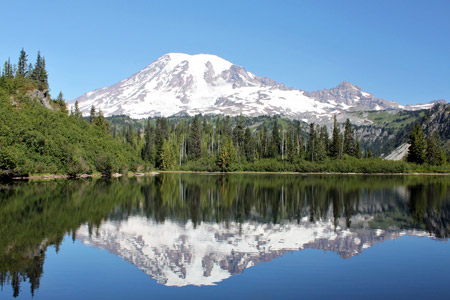This week, we celebrate not one, not two, but three amazing holidays that all focus on nature and the environment!

Today is Earth Day, a day when people around the country gather together to give thanks to Mother Nature. First celebrated on April 22, 1970, Earth Day is a yearly reminder that we need look after and care for our environment. American Forests, of course, does this 366 days of the year through forest restoration, public policy and advocacy, and much, much more.
It’s also National Park Week, in which the National Park Service (NPS) recognizes and celebrates all 401 properties in the system — from seashores to historic landmarks to national parks. And, we’re all invited to join the celebration, as the NPS is waiving all admission fees to the national parks this week!
On Friday, we wrap up this exciting environmental week with Arbor Day. Did you know that Arbor Day was celebrated for the first time in 1872, the same year that Yellowstone became our first national park? [For more on the history of Arbor Day and its connection to some national champion trees, check out our Big Tree story “Nebraska’s Garden of Eden.”] You could say that the 1870s were a pretty happening time for conservationists, as we had Yellowstone, the first Arbor Day and then, in 1875, American Forests was created! What an amazing few years, no?
But while history and celebrations are grand, the bigger picture here is Earth. How is she doing? Well, when it comes to forests, it’s a bit of a mixed bag.

In 2010, it’s estimated that forests covered almost 10 billion acres, or 31 percent, of the world’s total land area. That may sound like a lot until we put it in historical perspective: In the preceding 10 years, it’s estimated that Earth saw a net forest loss of 12.8 million acres each year. That’s almost 1.3 billion acres in just 10 years!
In the U.S., forests make up about a third of the total land area, a figure that has held fairly steady for the last century, but a simple percentage doesn’t tell the whole story. While they may technically still be standing, forestlands across the U.S. are under siege. Last year, more than nine million acres burned in wildfires. Last fall, in a mere few days, Hurricane Sandy damaged millions of trees along the East Coast. In northern Colorado and southern Wyoming, an average of 100,000 trees are killed daily by mountain pine beetles. Forests in our urban areas are also feeling pain: Approximately four million trees are lost in urban areas each year. And these are just a few examples.

Here at American Forests, we’ve designed programs to combat these threats facing our forests:
- Our Global ReLeaf program restores thousands of acres of forestland affected by natural and man-made disasters each year.
- Our Endangered Western Forests initiative is combatting mountain pine beetles, white pine blister rust and more in the West.
- Our Urban Forests program works with cities across the country to analyze and protect their urban forests.
So in honor of Earth Day, National Park Week and Arbor Day, will you join us in our fight to protect our forests by becoming a member or by having trees planted? We’ll see you in the forest.